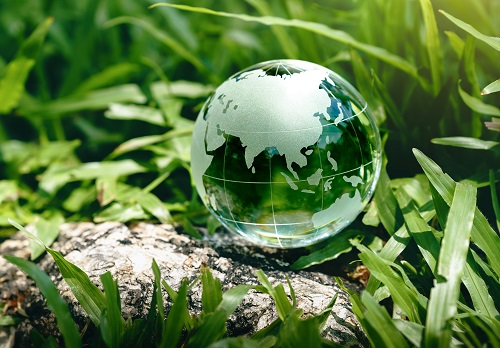
©stock.adobe.com/au/malp
Space tech such as EO must be embedded in environmental, social and governance programs by design.
By Anthony Jones
The importance of safeguarding the future of our planet is top of mind in corporate Australia today, with pressing environmental, social and governance (ESG) imperatives driving a multitude of inspiring applications of space technology.
October’s Australian Space Forum attracted a hybrid audience that included those working in upstream space tech — designing and manufacturing satellites, rockets and robots and putting them into orbit — as well as those creating the downstream products, services and solutions. Together, they are driving a newly flourishing Australian industry — Space 2.0 as Enrico Palermo, head of the Australian Space Agency, calls it.
Space tech has captured the imagination of all of us anew, but there is still a gap between what is being created and how it is being articulated to prospective customers. There are companies across every sector who are hungry to find out how downstream solutions, fuelled by upstream innovation, can help their businesses.
It is a whole new world for many of them, which means that it’s up to all of us to connect the dots — articulate the story of the kinds of things Earth observation (EO) data can do for them, beamed from space to help life on Earth.
The power of Earth observation
EY’s panel discussion at the Australian Space Forum focused on how space tech can transform the way we monitor, measure and report ESG metrics. This goes way beyond compliance — we see opportunities everywhere for space tech to embolden ESG goals and help deliver them.
The remit for ESG is broad. To achieve our ambitious goals, we need to better understand everything from emissions to biodiversity, from water use to health and safety… and a whole lot more. When we understand more, we can do better.
EO data is already incredibly detailed and improving all the time — we can detect chemical fingerprints in microorganisms that the human eye can’t even see. We can observe areas that were previously difficult to get to or even completely out of reach, and keep track of them from our eyes in the sky.

©stock.adobe.com/au/Deemerwha studio
There are so many applications for deploying EO data downstream to build solutions to some of the world’s biggest problems.
I know how powerful EO is going to be in helping our clients achieve their ESG goals, because we’re already using it. We’ve used EO to help one client discover water leaks without the need for manual inspections, and another to monitor vegetation growth around remote infrastructure, which has helped them improve fire management. Space tech has made operations for both companies vastly more efficient and, of course, it has improved environmental outcomes.
It’s early days, but our initial observations suggest there are greater gains to be made from embedding space tech into ESG from the start. If we agree that space is something of a greenfield, from the point of view of governance what do we need to prioritise to make sure we learn from past mistakes? What do we need to do to make sure we are on the front foot to operate responsibly in space, knowing that a lot of companies are today in a position of playing catchup to meet ESG requirements on Earth?
Everything’s moving pretty fast right now, with a lot of pressure on space tech companies to launch products — literally and figuratively.
Space is driving the most profound industrial revolution of our generation — some say the most significant of all time. Yet amid the excitement, we must reflect on the lessons of history. We can learn from the mistakes of previous industrial revolutions, and do better.
For instance, if you’re launching a rocket or satellite into space today, what happens to it in 40 years? We’ve recently seen space junk plummeting to Earth in rural Australia, and we know it’s going to be an issue as low-Earth orbit becomes a traffic jam of satellites. How do we plan for this and what can you do to make sure your company is one of the white hats in the wild west?
Responsible ESG
Cybersecurity, of course, also is absolutely critical in the Space 2.0 race, but we have the opportunity to embed security by design. From the inception of every idea — hardware or software — we must build scenarios for all the ways it could be compromised or hacked, and prioritise building-in security from the first iteration… and resist the temptation to release anything until we’ve had its security independently tested and validated.
And then there’s AI and machine learning. We know how powerful they are in assisting us to turn data into insights, reveal anomalies humans would miss and generally automate a whole lot of boring tasks — and all at speed. But we know that from a societal point of view there are several issues. It’s well known that there are questions about ethics and bias — how do you ensure the data you’re feeding your algorithms does not violate privacy or skew results that disadvantage certain groups?
We are also finally recognising the significant carbon footprint of training these huge data sets, which is one of the reasons why EY’s Space Tech Lab is invested in building a product that can scale for multiple clients, rather than bespoke tools for individual companies.
I hope to see all of us working in the space tech field — producers and consumers — taking the lessons we’ve learnt and embedding ESG principles into our business practices from the start.
Then, as we travel further along on our mission to help improve life on Earth, we’ll be able to comfortably say that we have been operating in (or with) space in a way that supports modern expectations of ESG on Earth, rather than having to fix mistakes later.
The wisdom of hindsight can become the gift of foresight as we take our terrestrial learnings into space.
Anthony Jones is Space Tech Leader for EY, a professional services consultancy.
This article was first published in Issue 116 (Dec/Jan 2022-23) of Position magazine.
Stay up to date by getting stories like this delivered to your inbox.
Sign up to receive our free weekly Spatial Source newsletter.












